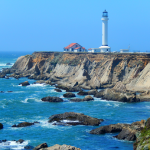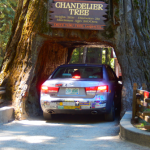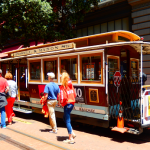Dexy is back to being my bff after two well-deserved weeks off in San Francisco. She’s raring to go as we head north along the coast on Hwy 1. First stop, Marin County. This is my first time in Marin – it’s just one of those subcultural things one should do, especially if one is me. Subcultural, meaning Van Morrison. The place of “Hardnose the Highway,” one of my go-to Van albums, so it’s good to drive through the neighborhood with my 1970s glasses on.
Our visit to Marin County is what you’d call a “day trip” – a stop in Mill Valley for lunch, on to Fairfax and San Anselmo, followed by a beautiful drive to the coast to join up with Hwy 1, turn right, and before you know it, we’re in Point Reyes Station. This is a cool little town, a bit of an Old West feel to it. The main reason we’ve stopped is to check out Gallery Route One, where Robbie’s cousin Vickisa has her French Quarter Fest book on display. Now that’s cool. She’s made the music, the whole sound of New Orleans, come alive on the pages. This is one person who gets New Orleans, the rain and all. There are also some creative types working the walls around town. Degas meets Clint Eastwood – it’s a bit spooky.
Hwy 1 north of Point Reyes Station, wending its way through the hills and in and out along the coastline, is the roller coaster ride of a lifetime, and the ups and downs and swerving all around are enough for Wendy to cry uncle and swear off “the scenic route” forever. Dramamine and Sea-bands aren’t much help at all, although the Dramamine lets her sleep through many of the curves in the road through Northern California in the days ahead.
Our first night’s stop is just over the Marin border in Sonoma County – at the very charming Bodega Harbor Inn in Bodega Bay. We’d been warned that the town closes up around 9 p.m. – just about the time of sunset, which closes whenever it feels like it.
It’s back to the twists and turns of the coast heading north through Sonoma and on into Mendocino County – the rugged coastline, the roadside wildflowers, the requisite lighthouse, just another pretty day on the California coast before we land in Fort Bragg to close out Day 2.
North of Fort Bragg is the little town of Westport, nestled on a band of coast beneath the wooded hills that spread to the east. In the grand scheme of things, Westport is but a small footnote, and most of that would be taken up with lumber stories from years gone by. And yet the scene of it has been etched in my mind these past three years since the day Bridget and I drove through the village late one afternoon. To all the world, or at least to all of me, it looked like a part of western Ireland had picked itself up and put itself down here two oceans away. And straight out of the Irish weather book, a deep fog has rolled in and settled about the place by the time Wendy and I arrive mid-morning. I think to myself that perhaps this small place will find a spot in my book, and ever industrious in that pursuit, I find and purchase a little history book of the town that I hope will give me a sense of this place during the last half of the 19th century.
scene of it has been etched in my mind these past three years since the day Bridget and I drove through the village late one afternoon. To all the world, or at least to all of me, it looked like a part of western Ireland had picked itself up and put itself down here two oceans away. And straight out of the Irish weather book, a deep fog has rolled in and settled about the place by the time Wendy and I arrive mid-morning. I think to myself that perhaps this small place will find a spot in my book, and ever industrious in that pursuit, I find and purchase a little history book of the town that I hope will give me a sense of this place during the last half of the 19th century.
North of Westport, Hwy 1 takes a jig-jag zig-zag east to Leggett, where that highway ends and we now join Hwy 101 as we continue north. But first, a stop in Leggett is a must, for the requisite photo op of Dexy driving through the massive Chandelier Tree, a magnificent redwood that’s a harbinger of what’s ahead of us just up the road. It’s a gorgeous day and a perfect spot to enjoy our picnic lunch.
Hwy 101 isn’t called the Redwood Highway for nothing, and soon we have crossed over from Mendocino into Humboldt County and are making our way to the Avenue of Giants, much of which traverses Humboldt Redwoods State Park. It’s hard to keep your eyes on the road when there is so much grandeur to take in; words become somewhat useless to describe the majesty of this place, and the only hope is that photographs capture at least a fraction of the beauty.
From the Avenue of Giants, it’s back onto 101 and a straight drive to Eureka on the coast, a most charming Victorian seaport that demands a stroll along the waterfront and plenty of window gazing in the many shops and galleries in the Old Town. And that’s how we spend our last night in California – taking in the picturesque, which is just a tiny bit of what the town has to offer.
Our final day in California is all about driving – plenty of miles up the coast till we reach Oregon – but first a stop at Holly Yashi in Arcata, just north of Eureka. We arrive in time for a tour of their facilities, where they design, create and make all their jewelry, plus a poke around the store, ogling the finished product. Neither of us can resist (which is the whole point, right?), especially after watching the acid bath that creates the various colors on metal, and we walk out the proud owners of Holly Yashi, in my case an elegant pair of earrings.
create and make all their jewelry, plus a poke around the store, ogling the finished product. Neither of us can resist (which is the whole point, right?), especially after watching the acid bath that creates the various colors on metal, and we walk out the proud owners of Holly Yashi, in my case an elegant pair of earrings.
Next stop, Oregon!

















































































































































































